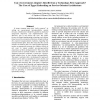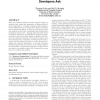2663 search results - page 33 / 533 » How to Choose a Timing Model |
HICSS
2010
IEEE
14 years 4 months ago
2010
IEEE
It seems common sense that “policy matters” in setting up e-government interoperability, mainly because collaboration should be guided by dedicated integration objectives and ...
IPTPS
2004
Springer
14 years 3 months ago
2004
Springer
In P2P systems, users often have many choices of peers from whom to download their data. Each user cares primarily about its own response time, which depends on how many other use...
ICSE
2010
IEEE-ACM
14 years 2 months ago
2010
IEEE-ACM
Each day, a software developer needs to answer a variety of questions that require the integration of different kinds of project information. Currently, answering these questions...
BMCBI
2004
13 years 9 months ago
2004
Background: The behaviors of cells in metazoans are context dependent, thus large-scale multicellular modeling is often necessary, for which cellular automata are natural candidat...
FM
2005
Springer
14 years 3 months ago
2005
Springer
Recently we have proposed the ”almost ASAP” semantics as an alternative semantics for timed automata. This semantics is useful when modeling real-time controllers : control str...



